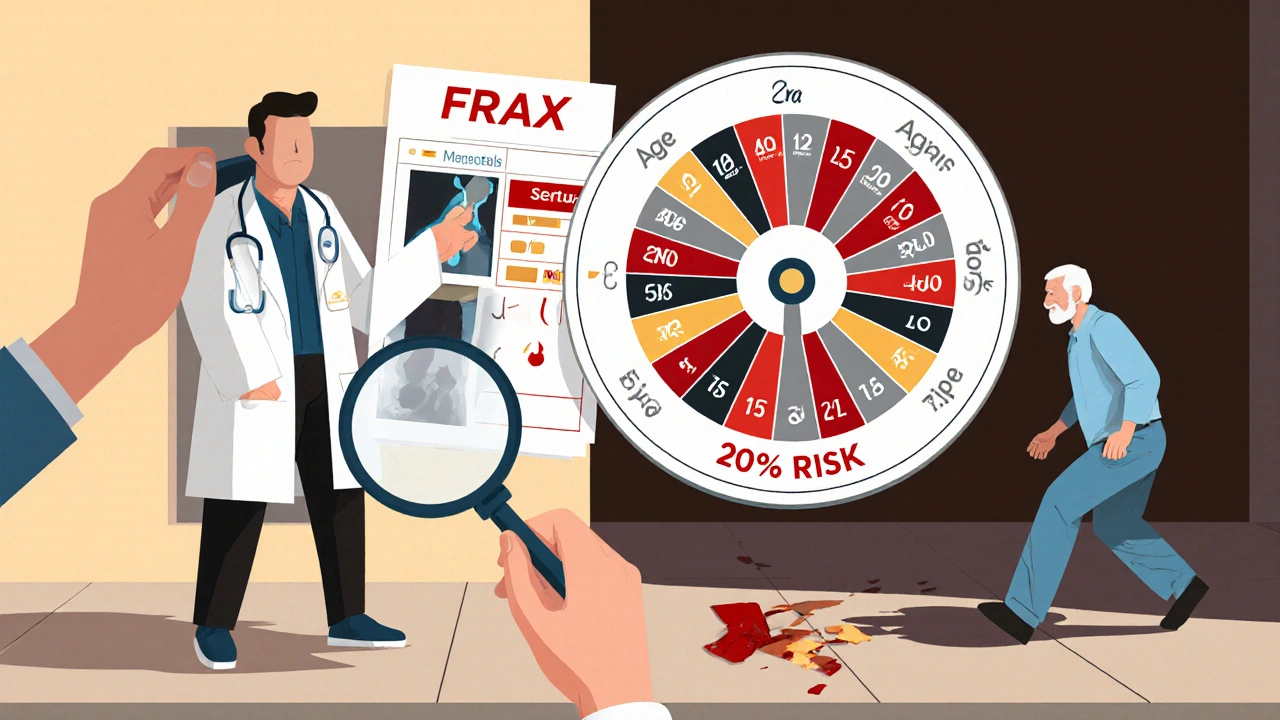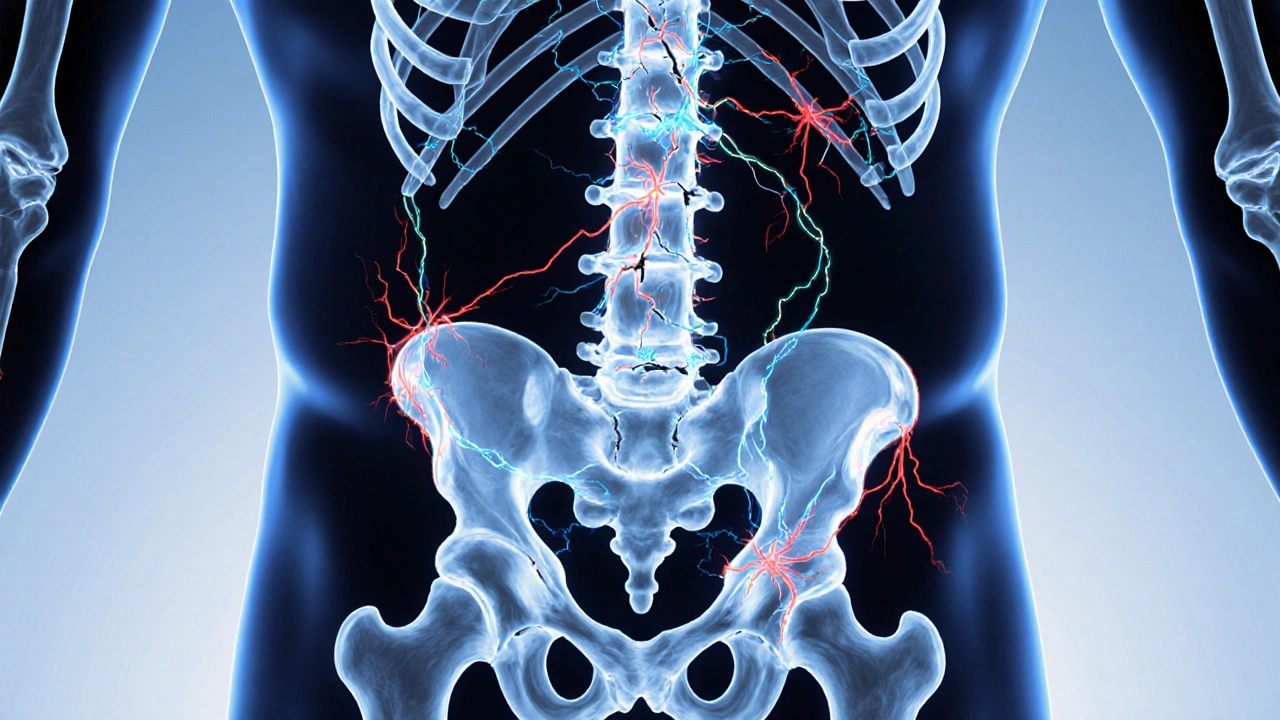When your hormones are out of balance, your bones pay the price. That’s the harsh reality for people with endocrine disorders like type 1 diabetes, hyperthyroidism, or hypogonadism. These conditions don’t just mess with energy, weight, or mood-they quietly eat away at bone strength, turning everyday slips into broken hips or crushed vertebrae. And here’s the twist: osteoporosis in these patients often shows up with normal bone density scans. That’s why guessing based on scans alone can be deadly.
Why Endocrine Disorders Break Bones
Your bones aren’t just static scaffolding. They’re living tissue, constantly being broken down and rebuilt by cells called osteoclasts and osteoblasts. Hormones like estrogen, testosterone, thyroid hormone, and insulin are the traffic cops of this process. When they’re off, the balance tips. In type 1 diabetes, bone density might look fine on a DEXA scan, but fracture risk jumps 6 to 7 times higher than normal. Why? High blood sugar damages collagen, weakens bone structure, and messes with nerve function, making falls more likely. The FRAX tool, which estimates fracture risk, misses this entirely-underestimating risk by about 30%. Untreated hyperthyroidism? Too much thyroid hormone speeds up bone turnover so fast that your skeleton can’t keep up. Even subclinical cases raise fracture risk by 15-20%. Hypogonadism-whether from low testosterone in men or early menopause in women-causes bone loss at 2-4% per year. That’s faster than most people lose muscle after a year of bed rest. And it’s not just hormones. Long-term steroid use for autoimmune conditions, malnutrition from celiac disease, or liver damage from chronic alcohol use all chip away at bone. These aren’t rare side effects-they’re core reasons why someone under 65 ends up with a broken hip.FRAX: The Tool That Sees Beyond the Scan
The FRAX tool isn’t magic. It’s math. Developed by the University of Sheffield in 2008, it calculates your 10-year risk of a major fracture using simple inputs: age, sex, weight, height, smoking, alcohol use, previous fractures, family history of hip fracture, rheumatoid arthritis, and steroid use. It can run with or without a DEXA scan. For endocrine patients, FRAX is critical because it forces doctors to look beyond the T-score. A 58-year-old woman with type 1 diabetes and a T-score of -1.8 might seem like she only has osteopenia. But if she’s a smoker, drinks more than two glasses of wine a day, and had a wrist fracture five years ago, her FRAX score could push her over the 20% major fracture risk threshold. That’s enough to start treatment-even if her scan looks "mild." FRAX is used in over 120 countries and built into most DEXA machines. But here’s the catch: it doesn’t fully account for endocrine disease. That’s why experts now use FRAX with the Trabecular Bone Score (TBS). TBS analyzes the texture of the bone on the DEXA scan-revealing micro-architectural damage that the T-score hides. In diabetes or hyperthyroidism, TBS often shows poor bone quality even when T-score says "normal." The US Preventive Services Task Force (2024) says: don’t scan everyone. Scan people who have risk factors. If you’re a postmenopausal woman over 50 with a history of thyroid disease, start with FRAX. If your score is above 9.3% for major fractures, get the scan. If it’s below, you might not need one at all.Bisphosphonates: The First-Line Defense
When the risk is high, treatment starts with bisphosphonates. These drugs-like alendronate (Fosamax), risedronate (Actonel), and zoledronic acid (Reclast)-stick to bone surfaces and shut down the osteoclasts. They don’t rebuild bone. They just stop it from vanishing. In clinical trials, bisphosphonates cut vertebral fractures by 40-70% and hip fractures by 40-50%. That’s not a small benefit. It’s life-changing. For a 70-year-old woman with hypogonadism and a history of wrist fracture, taking alendronate daily for three years might mean the difference between living independently and needing a nursing home. The guidelines are clear: treat if you have a T-score of -2.5 or lower, or if you’ve had a fragility fracture, or if you have osteopenia (T-score between -1 and -2.5) AND a 10-year FRAX risk of 20% for major fractures or 3% for hip fracture. These thresholds apply whether you have diabetes, thyroid disease, or no endocrine condition at all. But here’s where endocrine patients get special attention. If you’ve had multiple fractures, or if you’re on long-term steroids, or if you’re young and have type 1 diabetes, your risk is higher than the numbers suggest. Doctors may start treatment sooner or choose stronger options like annual IV zoledronic acid instead of weekly pills.
How Long Should You Take Them?
Bisphosphonates aren’t forever. Most people take oral versions for 3-5 years, or one annual infusion of zoledronic acid for 3 years. After that, you stop and recheck. Why? Because long-term use carries small but real risks-like atypical femur fractures or osteonecrosis of the jaw. These are rare, but they happen. That’s why doctors don’t just prescribe and forget. They use FRAX again after 3-5 years. If your fracture risk has dropped below the treatment threshold, you may go on a "drug holiday." For endocrine patients, this is tricky. If your diabetes is still poorly controlled or your thyroid levels are unstable, stopping treatment could mean rapid bone loss. That’s why follow-up isn’t just a scan-it’s a full check of your hormone levels, weight, mobility, and fall risk.What Doesn’t Work
Calcium and vitamin D? Essential. But they’re not enough. If you have endocrine-related osteoporosis, supplements alone won’t stop fractures. They’re the foundation, not the roof. Estrogen therapy? Not recommended for bone protection anymore. The risks of stroke, blood clots, and breast cancer outweigh the benefits for most women. Exercise? Absolutely. But weight-bearing activity alone won’t fix a 30% underestimation by FRAX. You need drugs if the risk is high. And don’t assume normal BMD means safe bones. That’s the biggest trap in endocrine disease. A man with type 1 diabetes and a T-score of -1.2 can still break a hip from a step off a curb. His bone quality is broken, even if the scanner says otherwise.


gent wood
November 13, 2025 AT 16:25Finally, someone lays out the brutal truth about endocrine-related osteoporosis without sugarcoating it. I've seen too many patients dismissed because their DEXA scan was 'just osteopenia'-only to end up in surgery six months later. FRAX isn't perfect, but it's the best tool we have to force clinicians to look beyond numbers. The TBS add-on? Game-changer. If your doctor isn't using it, ask why.
Barry Sanders
November 14, 2025 AT 17:17FRAX is a joke. It's based on data from white, elderly women. My cousin, 42, type 1 diabetic, T-score -1.5, broke his hip biking. FRAX said 8% risk. Reality? 50%. This tool is designed to protect insurance companies, not patients.
Sean Hwang
November 15, 2025 AT 20:02Biggest thing I learned? Normal scan doesn't mean safe bones. My dad had type 2 diabetes and a 'normal' DEXA-he fell getting out of the shower, broke his hip. Turned out his bone quality was trash. FRAX would've caught it. Talk to your doc, don't wait for a fracture.
Hrudananda Rath
November 16, 2025 AT 15:01One must lament the lamentable epistemological negligence exhibited by contemporary medical practice, wherein the reductionist paradigm of bone mineral density is fetishized as the sole arbiter of skeletal integrity. The very notion that a T-score, a crude statistical artifact derived from a Gaussian model of healthy young adults, can adequately represent the complex biomechanical degradation wrought by endocrine dyscrasias is not merely inadequate-it is grotesquely negligent. The FRAX algorithm, though a valiant attempt at quantification, remains woefully insufficient without the incorporation of microarchitectural integrity metrics such as TBS, which alone may reveal the silent, insidious erosion of trabecular connectivity. One wonders if the medical establishment is more invested in maintaining the illusion of diagnostic certainty than in confronting the visceral reality of patient suffering.
Brittany C
November 18, 2025 AT 03:08The TBS integration is underutilized. I've reviewed hundreds of DEXA reports in my practice, and fewer than 15% include TBS-even though it's automatically generated by the machine. Clinicians still treat the T-score like gospel. We need mandatory TBS reporting for endocrine patients. It's not optional anymore.
Sean Evans
November 18, 2025 AT 12:01Of course bisphosphonates are the answer. Everyone just wants a pill. Meanwhile, your gut is dying from the acid reflux, your jaw is rotting, and your femur is turning into glass. You think you're saving your spine? You're just trading one disaster for another. The real fix? Fix your hormones. Fix your diet. Fix your life. But nope-let’s just pump in chemicals and call it a day. Classic medicine.
kshitij pandey
November 19, 2025 AT 02:49This is so important for people in India too. Many think osteoporosis is just for old white women. My aunt, 48, had hypothyroidism for 15 years, never checked her bones. Broke her wrist lifting her grandkid. Now she’s on meds and walking with a cane. Please, if you have thyroid, diabetes, or PCOS-get checked. It’s not about age. It’s about your body.
Scarlett Walker
November 19, 2025 AT 08:18My mom’s on alendronate. She hates the pill. But she says it’s worth it. She’s 61, had a wrist fracture, type 2 diabetes, and smokes (bad, I know). FRAX said 22%. She started meds. Now she walks without fear. Just don’t skip the follow-up. That’s where people slip up.
Anjan Patel
November 19, 2025 AT 20:54Why do we even need FRAX? If you have diabetes and you're over 40, you're already at risk. Stop pretending you need a calculator. Just treat them. No math. No waiting. Just do the right thing. This over-analysis is killing people while they wait for a score.
Chris Ashley
November 20, 2025 AT 10:56bro i had a dxa scan last year and my doc said im fine but then i asked about my type 1 and he looked at me like i was crazy. i showed him this post and he actually changed his mind. now im getting tbs and a frax. thanks for this. you saved my bones.
Nathan Hsu
November 21, 2025 AT 01:14FRAX, TBS, bisphosphonates-yes, all critical. But let’s not forget the elephant in the room: vitamin D deficiency is rampant in South Asia, and many patients are severely deficient. No drug works if you’re not getting enough D. Check your levels. Supplement if needed. It’s cheap. It’s simple. It’s ignored.
Ashley Durance
November 21, 2025 AT 09:04People don’t understand that osteoporosis isn’t a side effect-it’s a direct consequence. You don’t get ‘a little bone loss’ with uncontrolled thyroid disease. You get collapse. You get deformity. You get disability. And if your doctor isn’t treating it like a medical emergency, they’re not doing their job.
Scott Saleska
November 22, 2025 AT 01:45Actually, I think the real issue is that we’re still using 2008 FRAX models. The new AI tools that integrate wearables and real-time glucose and hormone data? They’re already outperforming FRAX by 30% in trials. Why are we still clinging to this outdated tool? Because it’s easy. Because it’s in the EHR. Because change is hard. But we’re not helping patients-we’re just maintaining the status quo.